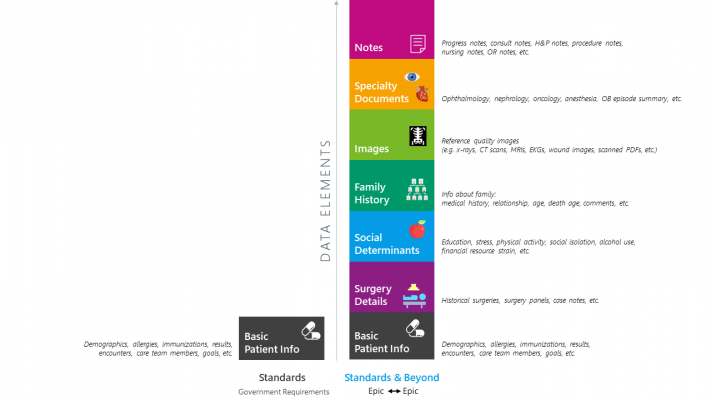Epic Interoperability Creates One Virtual System Worldwide

Verona, Wis. – Epic, creator of the most widely used comprehensive health record and interoperability network, today announced “One Virtual System Worldwide” so clinicians across all organizations using Epic can not only exchange more data, but can interact with each other on that data.
There are three parts to One Virtual System Worldwide:
- Come Together: Gather the data
- Happy Together: Present the combined data in an easy to read format
- Working Together: Take actions across organizations
“We’re taking interoperability from being able to ‘view more’ to being able to ‘do more,’” said Dave Fuhrmann, Epic Vice President of Interoperability. “Over the last decade we expanded the amount of data that customers can exchange, going well beyond industry requirements. Now, our new functionality ‘Working Together’ will allow clinicians to work across Epic organizations to improve the care for their patients.”
Come Together
Epic finds patient records and brings their data together from Epic organizations, organizations that use other EHRs, government, and networks. Epic customers exchange over 2.3 million patient records per day and approximately two-thirds of the people in the United States have a current record in Epic.

Data exchange between Epic sites includes more than 7 times the data elements government requires[1]. This includes specialty documents such as oncology and obstetrics, consult notes, progress notes, family history, and other clinical data critical to care.
Happy Together
Data are presented in a single, merged view, as easy to read as if they all came from the same organization, helping clinicians eliminate gaps in care, alerting them to possible opioid overuse or other medication problems, and helping them deliver better care faster. Happy Together in the MyChart patient portal lets patients see a combined view of their healthcare record without having to log in and out of different portals.
Working Together

Images Everywhere: See image thumbnails from other Epic customers. Click on the image you want to examine and Epic goes to the source and retrieves a reference quality image for your review.

Book Anywhere: Schedulers referring a patient to another Epic customer can directly book the appointment in that system.

Message Anywhere: Clinicians can send secure messages directly into the In Baskets of clinicians at other organizations, which is especially useful for those receiving referrals who want to have a deeper dialogue.

Search Everywhere: Searches data received from other organizations and examines discrete data as well as free text, such as in notes and documents.

Telehealth Anywhere: Patients can use Epic’s self-assessment triage and then self-schedule a televisit with their organization, or with another Epic organization if their own is not available.
What’s Next for Working Together

Duplicate Checks Everywhere: Alerts the clinician that the order just placed, for example for imaging or for a lab test, has recently been completed at another organization and may not be needed.

Schedule Anywhere: Patients with a referral from one Epic organization can see appointment options from the other Epic organization and schedule directly. New patients can also schedule directly.
“Ten years ago, MemorialCare was the first organization in the world to exchange a patient record via Care Everywhere. Of significance, the exchange capability was inherent with the Epic system. No incremental effort was required, and the results were available to clinicians in their native workflows, something that we had not been able to achieve in working with HIEs. Now we are taking a big step forward in interoperability by being part of a single virtual system with the rest of the Epic community,” said Scott Joslyn, CIO at MemorialCare Health System.
“Deploying Epic across our organization has not only enabled us to become deeply integrated within our own organization, but by leveraging Care Everywhere we have been able to share patient information across other organizations caring for that patient. Now, with One Virtual System Worldwide, we are excited to be able to join a connected community that we think can dramatically improve our efficiency and the quality of care we deliver to our patients,” said Darren Dworkin, CIO at Cedars-Sinai Health System.
[1] As required in ONC’s 2015 Edition Common Clinical Data Set



